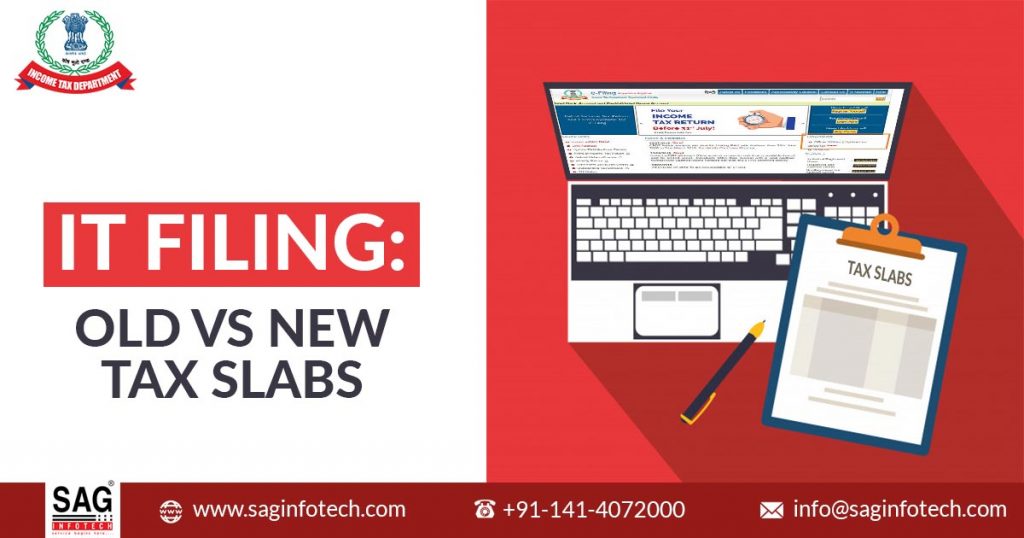Income Tax Filing; Old and New Tax Slabs, Due Date
Blog: NASSCOM Official Blog

Income tax is the undeniable charge that is levied by the government on every registered taxpayer resident of the country. Income tax is directly levied on the annual salary of the taxpayer and therefore is termed as “Direct Tax”.
The Income Tax Act
The list of norms was initially composed in 1961 and was first implemented in 1962. Income Tax as defined under section 4 of the Income Tax Act 1961, is the tax leviable on the aggregate value of the income earned by any individual, Hindu Undivided Family (HUFs) Association of Persons (AOP), Body of Individuals (BOI), a firm, a company, etc. in the preceding Financial Year.
Income Heads (under which income is segregated)
Salary – consisting of salaries, pension, annuity, gratuity, fees, commission, profits, leave encashment, Provident Fund (PF), etc.
House Property – Income Tax from house rent to the landlord. In case the house is vacant then a notional income is filled under this head.
Profits From Business & Profession – The section includes details on profit/loss from a business entity or a profession, any interest, salary or bonus to a partner of a firm.
Capital Gains – Income from long term (LTCG) and short term (STCG) capital gains upon selling the assets shall be recorded here.
Other Sources – Interests from bank deposits and/or shares/securities, dividend, royalty income, lotteries and races and gifts from others, etc.
Tax Leviable on Annual Income
Income tax is calculated on the basis of rates set for every income group. Therefore it is crucial for every taxpayer to know under which income tax rates slab does his/her annual income falls. Moreover, there is a certain threshold limit for tax payment, if your annual income is less than the threshold limit you are not liable to pay taxes.
Income Tax Rates (Old and New Tax Regime)
For the welfare of taxpayers, the government has come up with the new tax regime. Introduced via Union Budget 2020, the new regime is applicable on a voluntary basis (taxpayers can decide which tax regime to go with as per their benefits).
Income Tax rates are different in old & new slabs. The new regime consists of reduced tax rates as compared to the old regime. Here are the tax slabs for new as well as old tax regimes:
New Tax Regime
| Total income (Rs) | Income tax rate |
|---|---|
| Up to 2.5 lakh | Nil |
| From 2,50,001 to Rs 5,00,000 | 5% |
| From 5,00,001 to Rs 7,50,000 | 10% |
| From 7,50,001 to Rs 10,00,000 | 15% |
| From 10,00,001 to Rs 12,50,000 | 20% |
| Above 15,00,000 | 25% |
Old Tax Regime
| Total income (Rs) | Income tax rate |
|---|---|
| Up to 2.5 lakh | Nil |
| From 2,50,001 to Rs 5,00,000 | 5% |
| From 5,00,001 to Rs 10,00,000 | 20% |
| Above Rs 10,00,000 | 30% |
Key Pointers
1. The new tax regime does not support any deductions under the following investments (that were prior available under the old tax regime). So clearly the individuals, HUFs, GOIs or AOPs having investments in any of the following schemes are recommended to stick to the old tax regime.
- House Rent Allowances (HRA) u/s 10 clauses 13A
- Leave travel concession u/s 10 clauses 5
- Allowance to MPs and MLAs u/s section 10 clause 17
- Allowances u/s section 10 clause 14
- Exemptions under SEZ
- Standard deductions, entertainment allowance, employment tax mentioned under section 16
- Interests u/s 24 on self-occupied or vacant residential or commercial property
- Deductions on donations or any other scientific research.
- Deduction under section 80C,80CCC, 80CCD, 80D, 80DD, 80DDB, 80E, 80EE, 80EEA, 80EEB, 80G, 80GG, 80GGA, 80GGC, 80IA, 80-IAB, 80-IAC, 80-IB, 80-IBA, etc
- Deductions on LIC premiums for self, family or parents (should be resident of India)If the insurance claimer is:
- Below 60 yrs of age at the time of the deduction (exemption limit is up to 2,50,000)
- Above 60 yrs below 80 years (senior citizen) at the time of the deduction (exemption limit is up to 3,00,000)
- Above 80 years (super senior) (exemption limit is up to 5,00,000
2. Taxpayers with annual income up to Rs. 5 lakhs are eligible to get the rebate of Rs. 12,500 (u/s 87A) under both the regimes. So clearly taxpayers earning up to Rs. 5 lakhs per year are exempt from paying taxes.
Deadline to File the Income Tax Returns
Assessees are requested to file the returns on the government’s e-filing portal on or before the due date for Income Tax filing the annual returns.
Here is the List of IT Due Dates as Per the Taxpayer Categories:
- Every year 30 September of the AY for individuals, companies or any working partner whose accounts are required to be audited under the Income Tax Act 1961 or any other law.
- Every year 30 November of the AY, taxpayers who are required to file the returns under section 92E of IT Act.
Who is Liable to Pay tax?
Individuals, HUFs, groups of individuals (GOI) and Association Of Persons (AOP) whose annual income is more than the exemption limit designated by the government. Taxpayers falling under any category can be taxed lastly up to 30% of their annual earnings.
The post Income Tax Filing; Old and New Tax Slabs, Due Date appeared first on NASSCOM Community |The Official Community of Indian IT Industry.
